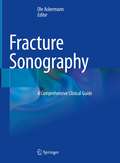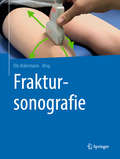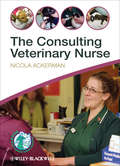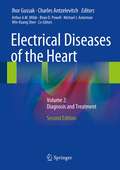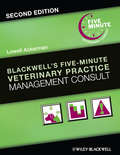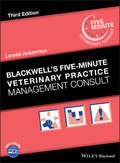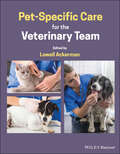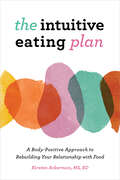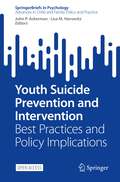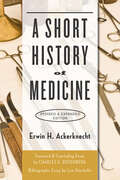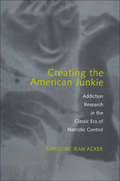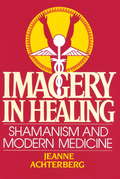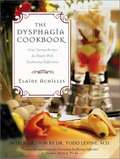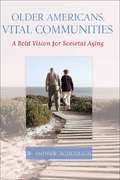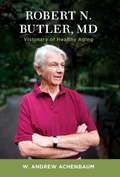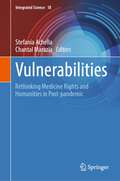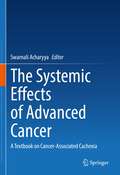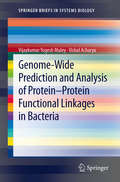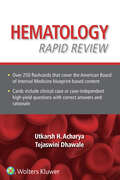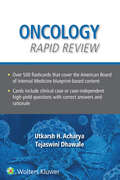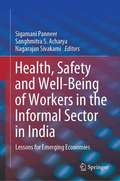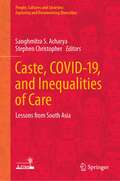- Table View
- List View
Fracture Sonography: A Comprehensive Clinical Guide
by Ole AckermannFilling a gap in the literature, this is the first book to comprehensively present fracture sonography as a diagnostic tool that can complement and in some cases even replace conventional radiological imaging. Guiding readers step by step through a patient examination, it is an invaluable guide to implementing this technique in clinical practice. It also presents algorithms, tips, tricks and pitfalls shared by experienced authors, making it a useful reference resource for all those practicing in the field. This book is of interest to a wide readership, including orthopedic, pediatric and trauma surgeons, emergency physicians, pediatric radiologists and general practitioners.
Fraktursonografie
by Ole AckermannDieses Buch bietet einen Überblick über das Spektrum der diagnostischen Fraktursonografie, die die konventionelle radiologische Bildgebung ergänzen und zum Teil auch ersetzen kann. Vorgestellt werden die apparativen und fachlichen Voraussetzungen, die Indikationen und Abläufe und die möglichen Gefahren. Algorithmen, Pitfalls und Tipps zur rechtssicheren Dokumentation runden die Fraktursonografie in der Praxis ab. Damit bietet das Werk alle relevanten Grundlagen zur Umsetzung in die Praxis.
The Consulting Veterinary Nurse
by Nicola AckermanThe Consulting Veterinary Nurse is an invaluable source of information for all veterinary nurses setting up and conducting their own nursing clinics in small animal practice. From the basics of setting up the consulting room to running and marketing individual clinics, this book provides a comprehensive coverage of the role of the consulting veterinary nurse. A large section of the book details specific clinics run by nurses, including nutritional assessments, behavioural clinics, puppy parties, seasonal information campaigns, senior pet clinics and medical clinics for a full range of conditions from arthritis and dental problems to epilepsy and cancer. A chapter specifically on rabbit clinics is also included.Written by an experienced senior veterinary nurse, this is a vital guide for all veterinary nurses seeking to develop their consulting role and contribute effectively to the long-term success of their practice.KEY FEATURESProvides a comprehensive guide to the role of the consulting veterinary nurseDetails specific nutritional, medical and behavioural clinics run by nurses Includes advice on presentation, marketing and communicating with clientsDiscusses client compliance and internal procedure and protocol Contains sample diet history sheets and unit conversion charts for use in practiceEndorsed by the British Veterinary Nursing Association
Electrical Diseases of the Heart, 2nd Edition, Volume 2: Diagnosis and Treatment
by Michael J. Ackerman Ihor Gussak Arthur A.M. Wilde Charles Antzelevitch Brian D. Powell Win-Kuang ShenElectrical Disease of the Heart, 2nd Edition, volume 2, covers the diagnostic and treatment options available in the management of electrical diseases and with its companion volume provides the latest developments in the field of experimental and clinical cardiac electrophysiology, genetics, pharmacology and interventional therapies of various clinical arrhythmogenic entities. This book is highly relevant to a broad audience, ranging from medical and graduate students, to clinicians and scientists.
Blackwell's Five-Minute Veterinary Practice Management Consult
by Lowell AckermanBlackwell's Five-Minute Veterinary Practice Management Consult, Second Edition has been extensively updated and expanded, with 55 new topics covering subjects such as online technologies, hospice care, mobile practices, compassion fatigue, practice profitability, and more. Carefully formatted using the popular Five-Minute Veterinary Consult style, the book offers fast access to authoritative information on all aspects of practice management. This Second Edition is an essential tool for running a practice, increasing revenue, and managing staff in today's veterinary practice.Addressing topics ranging from client communication and management to legal issues, financial management, and human resources, the book is an invaluable resource for business management advice applicable to veterinary practice. Sample forms and further resources are now available on a companion website. Veterinarians and practice managers alike will find this book a comprehensive yet user-friendly guide for success in today's challenging business environment.
Blackwell's Five-Minute Veterinary Practice Management Consult (Blackwell's Five-Minute Veterinary Consult)
by Lowell AckermanProvides a quick veterinary reference to all things practice management related, with fast access to pertinent details on human resources, financial management, communications, facilities, and more Blackwell's Five-Minute Veterinary Practice Management Consult, Third Edition provides quick access to practical information for managing a veterinary practice. It offers 320 easily referenced topics that present essential details for all things practice management—from managing clients and finances to information technology, legal issues, and planning. This fully updated Third Edition adds 26 new topics, with a further 78 topics significantly updated or expanded. It gives readers a look at the current state of the veterinary field, and teaches how to work in teams, communicate with staff and clients, manage money, market a practice, and more. It also provides professional insight into handling human resources in a veterinary practice, conducting staff performance evaluations, facility design and construction, and managing debt, among other topics. KEY FEATURES: Presents essential information on veterinary practice management in an easy-to-use format Offers a practical support tool for the business aspects of veterinary medicine Includes 26 brand-new topics and 78 significantly updated topics Provides models of veterinary practice, challenges to the profession, trends in companion practices, and more Features contributions from experts in veterinary practice, human resources, law, marketing, and more Supplies sample forms and other resources digitally on a companion website Blackwell's Five-Minute Veterinary Practice Management Consult offers a trusted, user-friendly resource for all aspects of business management, carefully tailored for the veterinary practice. It is a vital resource for any veterinarian or staff member involved in practice management.
Pet-Specific Care for the Veterinary Team
by Lowell AckermanA practical guide to identifying risks in veterinary patients and tailoring their care accordingly Pet-specific care refers to a practice philosophy that seeks to proactively provide veterinary care to animals throughout their lives, aiming to keep pets healthy and treat them effectively when disease occurs. Pet-Specific Care for the Veterinary Team offers a practical guide for putting the principles of pet-specific care into action. Using this approach, the veterinary team will identify risks to an individual animal, based on their particular circumstances, and respond to these risks with a program of prevention, early detection, and treatment to improve health outcomes in pets and the satisfaction of their owners. The book combines information on medicine and management, presenting specific guidelines for appropriate medical interventions and material on how to improve the financial health of a veterinary practice in the process. Comprehensive in scope, and with expert contributors from around the world, the book covers pet-specific care prospects, hereditary and non-hereditary considerations, customer service implications, hospital and hospital team roles, and practice management aspects of pet-specific care. It also reviews specific risk factors and explains how to use these factors to determine an action plan for veterinary care. This important book: Offers clinical guidance for accurately assessing risks for each patient Shows how to tailor veterinary care to address a patient’s specific risk factors Emphasizes prevention, early detection, and treatment Improves treatment outcomes and provides solutions to keep pets healthy and well Written for veterinarians, technicians and nurses, managers, and customer service representatives, Pet-Specific Care for the Veterinary Team offers a hands-on guide to taking a veterinary practice to the next level of care.
The Intuitive Eating Plan: A Body-Positive Approach to Rebuilding Your Relationship with Food
by Kirsten AckermanA gentle, comforting, body-positive approach to food It's time to explore and build new, positive relationships with food, moving away from restriction, deprivation, and obsession with body image. The Intuitive Eating Plan provides you with the information and steps necessary to heal your relationship with food and accept your body's beautiful intuition. You will be introduced to intuitive eating concepts that challenge what you previously believed about food, health, and wellness. Learn about the misconceptions of dieting, the mechanics and physiology behind hunger and satisfaction, how to address emotional eating, and how to make informed choices. Waiting for you on the other side is not only a healed relationship with food but also an intuitive eating bond that will impact every area of your life. The Intuitive Eating Plan includes: A healing reality—No matter what results you have attempted to achieve, come to terms with the fact that natural body diversity exists. Interactive approach—Explore questions about your beliefs on things like food and stress levels, and document your progress with questions and journal prompts. SMART goals—Use the proven SMART (Specific, Measurable, Achievable, Relevant, and Time-Based) method to effectively set attainable goals. Learn the principles of intuitive eating and reject the common diet mentality.
Youth Suicide Prevention and Intervention: Best Practices and Policy Implications (SpringerBriefs in Psychology)
by John P. Ackerman Lisa M. HorowitzThis open access book focuses on the public health crisis of youth suicide and provides a review of current research and prevention practices. It addresses important topics, including suicide epidemiology, suicide risk detection in school and medical settings, critical cultural considerations, and approaches to lethal means safety. This book offers cutting-edge research on emerging discoveries in the neurobiology of suicide, psychopharmacology, and machine learning. It focuses on upstream suicide prevention research methods and details how cost-effective approaches can mitigate youth suicide risk when implemented at a universal level. Chapters discuss critical areas for future research, including how to evaluate the effectiveness of suicide prevention and intervention efforts, increase access to mental health care, and overcome systemic barriers that undermine generalizability of prevention strategies. Finally, this book highlights what is currently working well in youth suicide prevention and, just as important, which areas require more attention and support. Key topics include: The neurobiology of suicide in at-risk children and adolescents.The role of machine learning in youth suicide prevention.Suicide prevention, intervention, and postvention in schools.Suicide risk screening and assessment in medical settings.Culturally informed risk assessment and suicide prevention efforts with minority youth.School mental health partnerships and telehealth models of care in rural communities.Suicide and self-harm prevention and interventions for LGBTQ+ youth.Risk factors associated with suicidal behavior in Black youth.Preventing suicide in youth with autism spectrum disorder (ASD) and intellectual disability (ID). Youth Suicide Prevention and Intervention is a must-have resource for policy makers and related professionals, graduate students, and researchers in child and school psychology, family studies, public health, social work, law/criminal justice, sociology, and all related disciplines.
One Hundred Names for Love: A Memoir
by Diane AckermanFinalist for the Pulitzer Prize Finalist for the National Book Circle Critics Award "A testament to the power of creativity in language, life--and love." --Heller McAlpin, Washington Post No other writer can blend the science of the brain with the love of language like Diane Ackerman. In this extraordinary memoir, she opens a window into the experience of wordlessness--the language paralysis called aphasia. In narrating the recovery of her husband, Paul West, from a stroke that reduced his vast vocabulary to a single syllable, she evokes the joy and mystery of the brain's ability to find and connect words. Deeply rewarding to readers of all kinds, Ackerman has given us a literary love story, accessible insight into the science and medicine of brain injury, and invaluable spiritual sustenance in the face of life's myriad physical sufferings.
A Short History of Medicine
by Erwin H. AckerknechtA bestselling history of medicine, enriched with a new foreword, concluding essay, and bibliographic essay.Erwin H. Ackerknecht’s A Short History of Medicine is a concise narrative, long appreciated by students in the history of medicine, medical students, historians, and medical professionals as well as all those seeking to understand the history of medicine.Covering the broad sweep of discoveries from parasitic worms to bacilli and x-rays, and highlighting physicians and scientists from Hippocrates and Galen to Pasteur, Koch, and Roentgen, Ackerknecht narrates Western and Eastern civilization’s work at identifying and curing disease. He follows these discoveries from the library to the bedside, hospital, and laboratory, illuminating how basic biological sciences interacted with clinical practice over time. But his story is more than one of laudable scientific and therapeutic achievement. Ackerknecht also points toward the social, ecological, economic, and political conditions that shape the incidence of disease. Improvements in health, Ackerknecht argues, depend on more than laboratory knowledge: they also require that we improve the lives of ordinary men and women by altering social conditions such as poverty and hunger.This revised and expanded edition includes a new foreword and concluding biographical essay by Charles E. Rosenberg, Ackerknecht’s former student and a distinguished historian of medicine. A new bibliographic essay by Lisa Haushofer explores recent scholarship in the history of medicine.
Creating the American Junkie: Addiction Research in the Classic Era of Narcotic Control
by Caroline Jean AckerHeroin was only one drug among many that worried Progressive Era anti-vice reformers, but by the mid-twentieth century, heroin addiction came to symbolize irredeemable deviance. Creating the American Junkie examines how psychiatrists and psychologists produced a construction of opiate addicts as deviants with inherently flawed personalities caught in the grip of a dependency from which few would ever escape. Their portrayal of the tough urban addict helped bolster the federal government's policy of drug prohibition and created a social context that made the life of the American heroin addict, or junkie, more, not less, precarious in the wake of Progressive Era reforms.Weaving together the accounts of addicts and researchers, Acker examines how the construction of addiction in the early twentieth century was strongly influenced by the professional concerns of psychiatrists seeking to increase their medical authority; by the disciplinary ambitions of pharmacologists to build a drug development infrastructure; and by the American Medical Association's campaign to reduce prescriptions of opiates and to absolve physicians in private practice from the necessity of treating difficult addicts as patients. In contrast, early sociological studies of heroin addicts formed a basis for criticizing the criminalization of addiction. By 1940, Acker concludes, a particular configuration of ideas about opiate addiction was firmly in place and remained essentially stable until the enormous demographic changes in drug use of the 1960s and 1970s prompted changes in the understanding of addiction—and in public policy.
Imagery in Healing: Shamanism and Modern Medicine
by Jeanne AchterbergThis influential book shows how the systematic use of mental imagery can have a positive influence on the course of disease and can help patients to cope with pain. In Imagery in Healing, Jeanne Achterberg brings together modern scientific research and the practices of the earliest healers to support her claim that imagery is the world's oldest and most powerful healing resource. The book has become a classic in the field of alternative medicine and continues to be read by new generations of health care professionals and lay people. In Imagery in Healing, Achterberg explores in detail the role of the imagination in the healing process. She begins with an exploration of the tradition of shamanism, "the medicine of the imagination," surveying this time-honored way of touching the nexus of the mind, body, and soul. She then traces the history of the use of imagery within Western medicine, including a look at contemporary examples of how health care professionals have drawn on the power of the imagination through such methods as hypnosis, biofeedback, and the placebo effect. Ultimately, Achterberg looks to the science of immunology to uncover the most effective ground for visualization, and she presents data demonstrating how imagery can have a direct and profound impact on the workings of the immune system. Drawing on art, science, history, anthropology, and medicine, Imagery in Healing offers a highly readable overview of the profound and complex relationship between the imagination and the body.
The Dysphagia Cookbook: Great Tasting And Nutritious Recipes For People With Swallowing Difficulties
by Elayne Achilles Todd Levine<P>The Dysphagia Cookbook is a specialty cookbook filled with nutritious, great-tasting recipes for those whose eating options are limited by chewing and swallowing difficulties. <P>All of the recipes focus on enhancing flavor, presentation, texture, aroma, and color, for there are many other products that supply nutritious calories or liquids but give little attention to these quality-of-life concerns.
Gynaecological Oncology for the MRCOG and Beyond
by Nigel Acheson David LuesleyA multidisciplinary approach to the care of women with gynaecological cancer - with treatment delivered in linked local or specialist centres - has been established in the UK. The second edition of this book therefore includes chapters which focus on the multidisciplinary approach. Chapters on pathology, radiology, chemotherapy and radiotherapy will increase understanding of these disciplines that are central to the care of women with gynaecological cancers. Chapters on laparoscopic surgery, basic surgical principles, palliative care, emergencies and treatment-related complications provide additional information. All content has been updated to reflect current practice and present the latest evidence on investigation, staging and management. The book is primarily designed to provide a comprehensive summary for candidates preparing for the Part 2 MRCOG examination, and as such covers the RCOG curriculum for gynaecological oncology. It is also a valuable guide for all healthcare professionals working in the field, including trainees, consultants and midwives.
Older Americans, Vital Communities: A Bold Vision for Societal Aging
by W. Andrew AchenbaumThis thought-provoking work grapples with the vast range of issues associated with the aging population and challenges people of all ages to think more boldly and more creatively about the relationship between older Americans and their communities. W. Andrew Achenbaum begins by exploring the demographics of our aging society and its effect on employment and markets, education, health care, religion, and political action. Drawing on history, literature, and philosophy, Achenbaum focuses on the way health care and increases in life expectancy have transformed late life from a phase characterized by illness, frailty, and debility to one of vitality, productivity, and spirituality. He shows how this transformation of aging is beginning to be felt in programs and policies for aging persons, as communities focus more effort on lifelong learning and extensive civic engagement. Concerned that his own undergraduate students are too focused on the immediate future, Achenbaum encourages young people to consider their place in life's social and chronological trajectory. He calls on baby boomers to create institutional structures that promote productive, vital growth for the common good, and he invites people of all ages to think more boldly about what they will do with the long lives ahead of them.
Robert N. Butler, MD: Visionary of Healthy Aging
by W. Andrew AchenbaumRobert Neil Butler (1927–2010) was a scholar, psychiatrist, and Pulitzer Prize–winning author who revolutionized the way the world thinks about aging and the elderly. One of the first psychiatrists to engage with older men and women outside of institutional settings, Butler coined the term "ageism" to draw attention to discrimination against older adults and spent a lifetime working to improve their status, medical treatment, and care.Early in his career, Butler seized on the positive features of late-life development—aspects he documented in his pathbreaking research on "healthy aging" at the National Institutes of Health and in private practice. He set the nation's age-based health care agenda and research priorities as founding director of the National Institute on Aging and by creating the first interprofessional, interdisciplinary department of geriatrics at New York City's Mount Sinai Hospital. In the final two decades of his career, Butler created a global alliance of scientists, educators, practitioners, politicians, journalists, and advocates through the International Longevity Center. A scholar who knew Butler personally and professionally, W. Andrew Achenbaum follows this pioneer's significant contributions to the concept of healthy aging and the notion that aging is not synonymous with physical and mental decline. Emphasizing the progressive aspects of Butler's approach and insight, Achenbaum affirms the ongoing relevance of his work to gerontology, geriatrics, medicine, social work, and related fields.
Vulnerabilities: Rethinking Medicine Rights and Humanities in Post-pandemic (Integrated Science #18)
by Stefania Achella Chantal MaraziaDrawing from a wide array of disciplinary perspectives and geographical contexts, this volume offers new insights for critically engaging with the problem of vulnerability. The essays here contained take the move from the COVID-19 pandemic, in order to explore the inherent vulnerability of individuals, but also of social, economic and political systems, and probe the descriptive and prescriptive import of the concept.Each chapter provides a self-contained perspective on vulnerability, as well as a specific methodological framework for questioning its meaning. Taken together, the chapters combine into a multi-disciplinary toolkit for approaching the various forms and structures of vulnerability, with a special attention to the intersectional factors shaping the individual experience of it: from gender to age, from disability to mental illness, from hospitalisation to incarceration. The book explores the theoretical richness and complexity of the concept and proposes new analytical approaches to it, before illustrating its multifariousness through empirically grounded case studies. The closing section engages with “the future of vulnerability”, as a hermeneutic, epistemological, and critical-normative perspective to be deployed beyond the domain of global crises and emergencies.The volume is primarily intended as a reference for scholars in the human, social and health sciences. The accessible structure and plain language of the chapters make it also a valuable didactic resource for graduate courses in philosophy, the social sciences and public health.
The Systemic Effects of Advanced Cancer: A Textbook on Cancer-Associated Cachexia
by Swarnali AcharyyaThis textbook discusses the systemic consequences of cancer, covering a range of topics from tumor-promoting systemic effects to the development of cachexia, as summarized in the introductory chapter 1. Part I of this textbook focuses on tumor-promoting systemic effects and begins with a chapter on how tumor-derived extracellular vesicles and particles lay the foundation for future metastases (Chapter 2). Chapter 3 discusses how metastatic cells that have colonized the bone impact the local bone microenvironment, neighboring muscles, and host physiology. Chapter 4 summarizes the available strategies for targeting metastatic cancer and emphasizes the need to incorporate a systemic view of the disease. Following this overview of the systemic effects of cancer progression, Part II of the textbook discusses cancer-induced cachexia, a debilitating systemic effect of advanced cancer. Chapters 5-7 examine the key signaling pathways (interleukin-6/GP130, NF-kB, and muscle proteolysis) that drive the development of cancer cachexia. Chapters 8 and 9 in Part III of this textbook explore how toxicities from anti-cancer therapy are associated with the onset of cachexia in cancer patients, and provide insight into potential approaches to simultaneously target both cancer and cachexia. Chapters 10 and 11 (Part IV) conclude this textbook by outlining promising approaches for the diagnosis and treatment of cachexia as well as strategies to prevent the development of cachexia through exercise. An understanding of the systemic effects of cancer is essential for the design of effective anti-cancer and anti-cachexia treatment strategies. As such, this textbook provides key information for both students and scientists engaged in cancer research and oncology.
Ground Water Contamination in India: Adverse Effects on Habitats
by Achiransu Acharyya S. P. Sinha RayThis book examines contamination in groundwater. Groundwater is a lifeline for most countries of the world. 90% of the Indian population rely on groundwater-based drinking water as safe mode of water supply. The terminology contamination in groundwater along with adverse effect on habitats, suggests the impact of such contamination in not only for drinking water, but also for agricultural irrigation. In addition, polluted groundwater causes adverse health hazards including social aspects that affect wider communities. Impacts on plant life also are equally threatening. This book provides readers with an insight into groundwater contamination in India. The economic loss associated with this devastating phenomenon is also studied in detail, which has a direct bearing to the country's GDP.
Genome-Wide Prediction and Analysis of Protein-Protein Functional Linkages in Bacteria
by Vishal Acharya Vijaykumar Yogesh MuleyUsing genome sequencing, one can predict possible interactions among proteins. There are very few titles that focus on protein-protein interaction predictions in bacteria. The authors will describe these methods and further highlight its use to predict various biological pathways and complexity of the cellular response to various environmental conditions. Topics include analysis of complex genome-scale protein-protein interaction networks, effects of reference genome selection on prediction accuracy, and genome sequence templates to predict protein function.
Hematology Rapid Review: Flash Cards
by Utkarsh Acharya Tejaswini M DhawaleFace the hematology board certification with confidence! Hematology Rapid Review, created and edited by Drs. Utkarsh H. Acharya and Tejaswini Dhawale, is a conveniently portable and effective review tool that helps learners at all levels prepare for this challenging exam. Sturdy, full-colored, flash cards provide an efficient and focused review anytime, anywhere.
Oncology Rapid Review Flash Cards
by Utkarsh Acharya Tejaswini M DhawaleFace the oncology board exam with confidence! Oncology Rapid Review, created and edited by Drs. Utkarsh H. Acharya and Tejaswini Dhawale, is a conveniently portable, effective review tool that helps you prepare for this comprehensive and challenging exam. Sturdy, full-color flash cards provide a focused, case-based review anytime, anywhere.
Health, Safety and Well-Being of Workers in the Informal Sector in India: Lessons for Emerging Economies
by Sanghmitra S. Acharya Sigamani Panneer Nagarajan SivakamiThis book focuses on the core problems of occupational health, safety and well-being of workers in the informal sector in developing countries, where it accounts for most of the rural labour force and a substantial percentage of the urban labour force. The sector is characterised by low incomes, unstable employment and lack of protection in the form of legislation/policies or trade unions. Though some health and problem-solving measures have been introduced, a focused academic effort to address the problems confronting workers in the unorganised sector, or informal economy, is lacking.The book evaluates workers’ physical and mental health in the context of labour migration, social inclusion of minorities and the differently abled, provisions for women workers, demonetisation, occupational safety for hazardous work, and in connection with various areas of informal work, e.g. agriculture, construction, transportation, sanitation, tanning, the tobacco industry, powerloom industry, surrogacy, and self-employment. It provides a well-rounded description of an analytical reflection on the challenges these workers face and focuses on social policy changes to help alleviate them. Accordingly, it offers a valuable asset for researchers and students interested in development studies, the sociology of work, health and labour economics, public health, and social work.
Caste, COVID-19, and Inequalities of Care: Lessons from South Asia (People, Cultures and Societies: Exploring and Documenting Diversities)
by Sanghmitra S. Acharya Stephen ChristopherThis book explores how social discrimination in South Asia contributes to health disparities and impedes well-being. Specifically, it addresses how marginalization shapes health outcomes, both under normal circumstances and specifically during the COVID-19 pandemic. Coming from diverse backgrounds and representing different academic disciplines, the authors have contributed a range of chapters drawing from quantitative and ethnographic material across South Asia. Chapters address reservation politics, tribal lifeways, Dalit exclusions from governmental institutions, Muslim ghettoization, gendered domestic violence, social determinants of health among migrant workers, and the pandemic fallout across South Asian society, among other subjects. Scholars draw on decades of experience and firsthand ethnographic fieldwork among affected communities. The chapters provide an innovative analysis, often in real time, of the human toll of casteism, classism, patriarchy, and religious intolerance—many set against the spectre of COVID-19. Many authors not only present social critiques but also offer specific policy recommendations. The book is of great interest to social scientists, public health practitioners, and policy advocates interested in addressing systemic inequalities and ensuring that future pandemics are not disproportionately felt by the most vulnerable.
